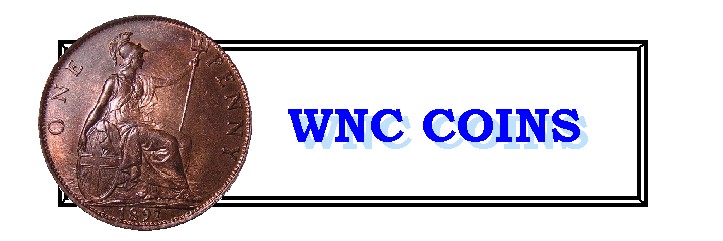
GRADING MINT STATE FRANKLIN HALF
DOLLARS
by Frank Chiong
Franklin Half Instructional
Series: Grading Uncirculated Franklins
From time to time we have discussed Franklins in every manner, from “Guess the
Grade” to looking at toning, color and so forth. I’m encouraged by the
fact that we are seeing more and more interest in this series, even though a lot
of people scoff at poor old Frankies as either an ugly coin or a bullion coin.
So be it. One of the wonderful things about this hobby is that no matter which
coin you chose, there is likely to be a following for it. Personally I was
always drawn to the Franklin because it is the first big coin that I was
introduced to when I started collecting long ago. I remember looking at it and
being taken by the fact that it was different from most of the coins that I had
seen. It has IN GOD WE TRUST where the date should be, it doesn’t have a
president or Miss Liberty on it, it’s got this big huge bell and this teeny
little eagle on it. So slowly but surely good ol’ Franklin became a favorite
and it still is.
Sources for this series generally include “An Analysis of Gem Franklins” by
Jack Ehrmantraut and “The Complete Guide for Franklin Halves” by Rick
Tomaska – two books which I feel every serious Franklin collector should read
Grading Uncirculated Franklin Half Dollars:
The key to grading Franklins, or any other series for that matter, lies in
knowing the series by date. Franklins, as with many other coins, have subtle
differences which characterize the coins by year and mint. This is one of the
main reasons why new collectors should read up on a series, so they can
understand the subtleties of coins offered by different years and mints. Which
coins have what kind of luster? Which coins have strong strikes versus weak
strikes? Which coins are more common with toning or without? Questions like
these have to be answered by understanding a year by year analysis of any given
series, which is why I embarked on the instructional series for those who have
an interest in Franklins, and for those who want to learn more about this
series.
First Impressions: Luster:
Whenever you look at Franklins, the first impression that the coin gives you is
going to be a key to determining how you approach the coin for grading purposes.
In my mind, the first thing that you look at when grading Franklins to determine
uncirculated state is Luster. Franklins come in all different levels of luster
by year and mintmark, but generally speaking, there is a certain look that coins
have when they are in pristine condition, and this is the look that you want to
go for when you first look at a Franklin. A question you should ask yourself is
does the coin look brand new? Silver coins, especially large ones, tend to have
what is called cartwheel luster. When you turn the coin under a light, you will
see the coin reflect the light much like the way cartwheels would stop in old
western movies. It is this kind of look, whether you’re looking at a brilliant
coin, or a toned one, that you first want to discern. Truly uncirculated
Franklins will almost always have this look. As the coin starts seeing wear or
friction, this pattern starts to break up. And here is where you have the first
clue on discerning lightly circulated coins from true MS coins.
On gem coins, whether white or toned, always look for “booming” luster:
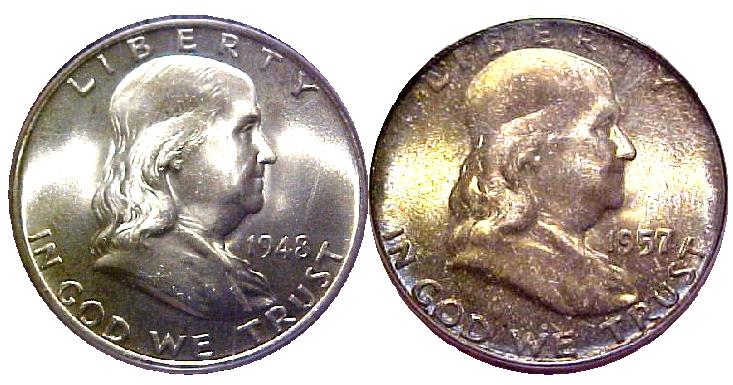
When looking at a
Franklin to determine the difference between AU and BU, first look for that
characteristic luster pattern. The next areas of focus should be on the cheek
bone, and the top of Franklins head on the obverse, and on the trestle of the
bell on the reverse. Generally what I’ll do is turn the coin at a 45 degree
angle to the light, and look for rub marks, or changes in the coloration between
the fields immediately before and after these areas. On certain coins this will
look like a dulling of the luster, so you will see a shiny field, then dull
grayish color, then shine again. Other times you might see a frosted look,
followed by a bright, almost polished or slick looking spot, followed by frost
again. Either way, if you see a change in the way the coin looks, this should
throw up a red flag for you.
For these reasons, it is important to use good lighting, and reasonable
magnification as necessary when looking at these coins. A good 100 watt bulb
will generally yield the type of illumination that you will want to have. For
those of us with less than perfect vision, a 5X loupe provides enough
magnification to view these details without getting so close that you lose sight
of the entire coin.
Luster on Franklins will range from brilliant, to satiny, to granular, with an
occasional semi-prooflike to prooflike coin thrown in just to stir the pot.
Because of the fact that inadequate strike pressure was used in minting the
coins, some coins, like the 1951S half, will run the gambit from awesome
brilliance to an almost slick look when the dies were about to give out. It pays
to look at as many slabbed coins as you can to learn the difference in
brilliance status for Franklins.
In general terms then:
MS66 and 67 coins:
Luster should grab your attention immediately – these coins just boom with
luster that’s unmistakably mint fresh and original.
MS65 and 64 coins:
Luster should be above average to great – definitely noteworthy.
MS63 coins:
Luster maybe good, but now it starts being impaired by marks. In other words,
you see the marks before you notice the luster.
AU to MS62 coins:
You definitely notice that the boom isn’t there. Marks or luster breaks take
your attention away from the mint luster, especially when you compare these
coins to MS65 and above coins.
Second – Strike Characteristics.
As I’ve talked about in previous instructional series, the master die on
Franklin halves started deteriorating soon after 1949. As such, I divide the
strike characteristics that you see on Franklins into five categories – 1948
to 49 coins, 1950 to 54 coins, 1955 to 59 coins, 1960’s coins, and “S”
mint coins from 1949 to 54.
1948 and 49 coins generally have the best strike characteristics of any
Franklins. On these you generally see all the intended details of the coins when
you’re looking at full gem status coins. Hair detail is crisp, the JRS
initials on the truncation of the bust are well defined, and the three wisps of
hair by Franklin’s ear are there. On the reverse, the bell lines are bold and
well defined, the eagle’s feathers are distinct, and the “Pass and Stow”
is visible to the naked eye. If you get a coin in this condition, combined with
great luster, you are half way to a knockout coin.
On 1950 to 54 coins, one of the first places you start seeing loss of detail is
in Franklin’s hair. Instead of crisp defined locks, they start bunching
together. In addition, particularly on “P” and “S” mint coins, you start
seeing the three wisps of hair begin to disappear. On the reverse, the eagle’s
feathers start losing detail, “Pass and Stow” becomes mushier, and of course
the bell lines start to disappear more frequently. Thus you have dates like
1950P and D, where the incidence of Full Bell Line coins is about 60 to 70
percent. As you go on up the line, toward 1953 and 54, the bell line detail
fails more and more. A lot of this had to do with the mintages and the strike
pressure that the presses were set at. Philadelphia coins seem to have fallen
prey to less than ideal strike pressure and the over use of dies. This is one
reason that finding a solid 1953P is so very difficult. On the other hand,
Denver coins from this period, except for 1950, tended to be very well struck.
The thinking is that, even though mintages tended to be high, dies were not used
until they were totally exhausted, and heavier striking pressure was used as
well.
On 1955 to 59 coins, the condition of the master die was noticeably failing.
Less detail is seen on most of the features of the coins. You’ll be hard
pressed to find a Franklin with the three wisps of hair showing clearly. In
addition, Pass and Stow is generally blurred, and the eagle’s feathers are
many times not very clear. For these reasons, over a period of time, the grading
of Franklins got away from looking at these areas for fully struck coins, they
just weren’t available. In addition to the above, I find that the bell lines,
even on Full Bell Line coins, are definitely weaker than in earlier years. Yes
you will find FBL coins obviously given the populations, but they’re not as
bold as in the early years. The thinking here is that when new dies were put in
the presses, you got Full Bell Lines, as the die wore off, you’d start seeing
the bell lines degrade, and you’d also start seeing the granularity that is
typical in average uncirculated offerings from these dates.
In 1960 the dies were reworked, and you have more detail returned to Franklin
halves, although this time the coins come in a slightly lower relief.
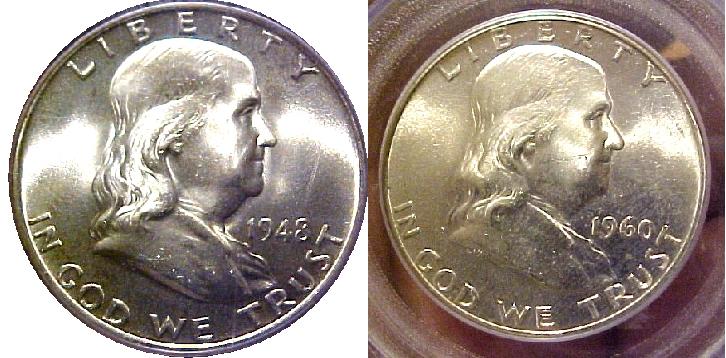
Because of the lower
relief utilized, the bell lines were not as bold as in the past, so what you see
is a myriad of very nicely struck coins, but with lack of bell line detail, thus
making 1960’s FBL coins very hard to find. Only those struck with fresh dies
would show full bell lines. Add to this the huge mintages, the poor handling,
and the weaker design, and you begin to understand why it’s so hard to find
fully struck coins from this period.
The final category that I lump Franklins into as far as strike characteristics
are the “S” mint coins from 1949 to 1954. For most Frankie collectors, the
“S” mints are the heartbreakers in the series. The reason, lack of pressure
from the mint presses, As a result of this, most “S” mint coins come with
weak detail at best, and almost always without Full Bell Lines. Obviously this
is not always the case, but in general what you find with these coins is that
very few sport the characteristics of their P and D counterparts. While mint
frost is fairly good on these coins for the most part, a great majority of the
coins will have granularity on Franklin’s portrait and on the bell due to lack
of metal flow to the deepest recesses of the die. In addition, in many coins,
particularly on 1954S offerings, you see upper bell line detail fade, especially
in the upper right quadrant of the bell lines.
So, taking all of this into consideration, here’s how I look at Franklins as
far as strike characteristics:
MS66 and 67 coins:
Should have a very solid strike given the characteristics of the date. In many
cases, even considering the striking characteristics of the date, you will still
be hard pressed to give coins minted after 1958 grades above MS65.
MS65 and 64 coins:
Coins should be well struck given the minting characteristics of the coins,
depending on when they were struck. Although I don’t necessarily agree that an
MS65 coin should have nearly no bell details as you see on some 1960’s MS65
coins, you will see this on occasion. To me, coins in this category should offer
as much detail as possible with some consideration to the above mentioned items.
MS63 coins and below:
Average to below average strikes, mushy details, some MS coins may even look
like they have been slightly circulated.
Third – Marks and Wear:
Because Franklins are large coins, this has been one of the main reasons why it
is so hard to find Franklins in pristine MS65 condition and above for many
dates. Poor handling at the mint, high mintages, and poor after market care of
these coins have all contributed to the relative scarcity of full gem condition
coins for this series.
When looking at Franklins, my baseline is an MS65 coin. In my mind an MS65 coin
is exactly half way between a beat up MS60, and a perfect MS70. As such, an MS65
will be gem quality, but may have a few marks that will detract its grade. When
I look at a Franklin half for marks, I will look at the coin with the naked eye
first to see what impression I get from the coin. Does the coin look mark free,
or are there marks, particularly on Franklin’s cheek, on the field immediately
in front of the bust, or on the bell, that attract my attention right away. If
the coin has larger marks that I can immediately catch with the naked eye,
especially in the aforementioned areas, it is immediately relegated to a grade
MS64 or below.
The next step I take is to look at the coin under 10X magnification, to see how
many marks there are and where they’re located. The prime areas of focus are
the face of the bust, the shoulder, the field in front and behind the bust on
the obverse, and the bell and the fields surrounding the bell on the reverse.
Because Franklins are such simply designed coins with lots of open space, these
areas are very evident, and as such leaves almost the entire coin vulnerable to
hits. Again, using MS65 as my baseline, I generally allow for a few “ticks”
on the coin, and perhaps one minor hit in one of the near one of the focal
areas. OK so what the hell does that mean? To me it means that I will not accept
a coin with a big gash, or more say 7 or 8 small ticks to grade MS65 or above.
If under a 10X loupe you see a noticeable hit or reed mark on the face or on the
bell, it goes to MS64 or below. The same applies if you see more ticks than
you’re comfortable with. The focal points and the fields should be primarily
free of distractions. Once distractions become evident, then the coin gets
downgraded.
The best way to judge marks is to just look at a lot of graded coins and get a
feel for what the coins should look like:
MS66 and 67 coins: MS67 coins are about as perfect as you can get with a
Franklin. Maybe one or two minute marks in hidden places, otherwise the coin
should look as if someone practically caught it as it was being released from
the presses. An MS66 coin can have maybe three or four tick marks on the hair or
shoulder or on the lettering in the obverse, or on the lettering or trestle on
the reverse, but the face needs to be just about blemish free. A few very very
minor distractions can be found on the bell itself.
MS65 and 64 coins: On MS65 coins you would see maybe a few more ticks than on an
MS66, with maybe one noticeable mark in the hair, the lettering, the trestle, or
the bell clapper. To me any noticeable mark on Franklin’s face, or on the
field around in front of the bust, would preclude the coin from an MS65 grade.
You can get away with one noticeable mark on the reverse, depending on how big
it is, if for example you have an MS66 obverse and an MS64 reverse. On MS64
coins, you generally start seeing a noticeable hit on Franklin’s cheek, or on
the bell, plus noticeable chatter, although it can still be a very nice coin.
MS63 coins and below are the typical offering that you see on Franklins. Lots of
chatter and hits determine the grade in which the coins will fall into and at
this level you’re basically looking at bullion priced coins.
True gem coins have to have luster, strike, and a minimal number of hits to make
them truly exceptional.
MS-66 EXAMPLES:
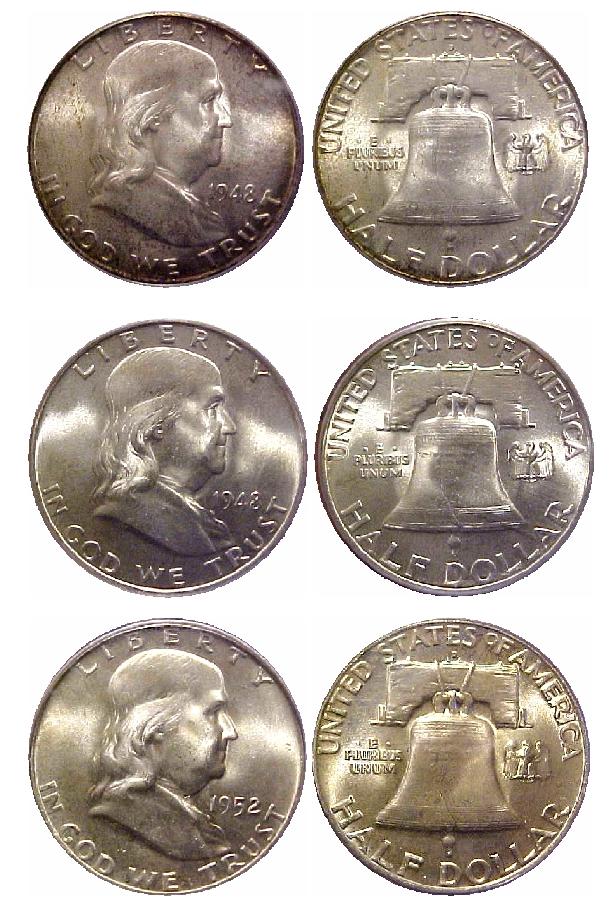
MS-65 EXAMPLES:
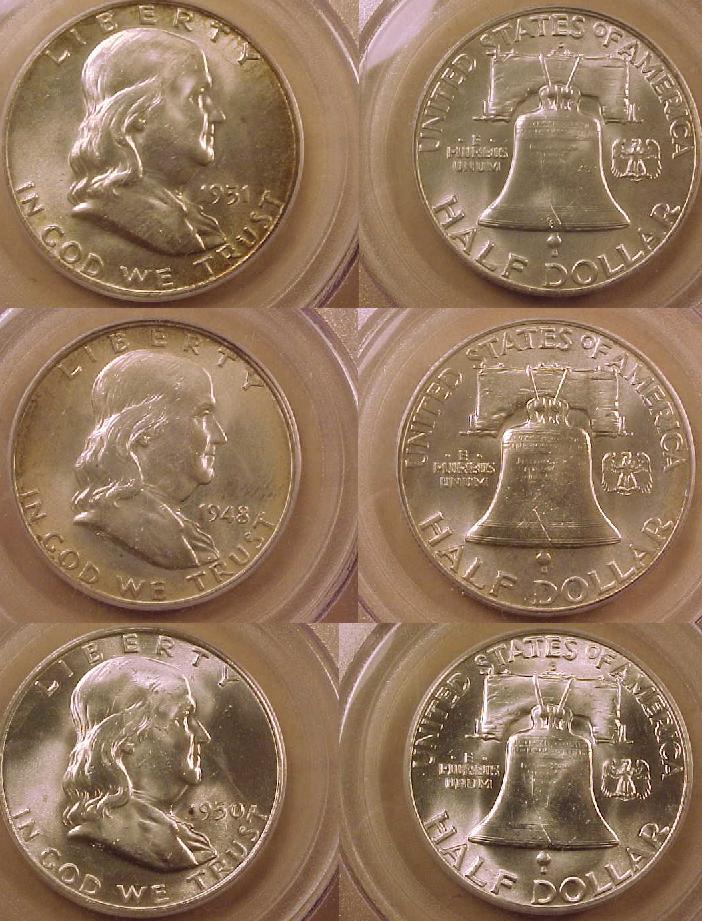
MS-64 EXAMPLES:
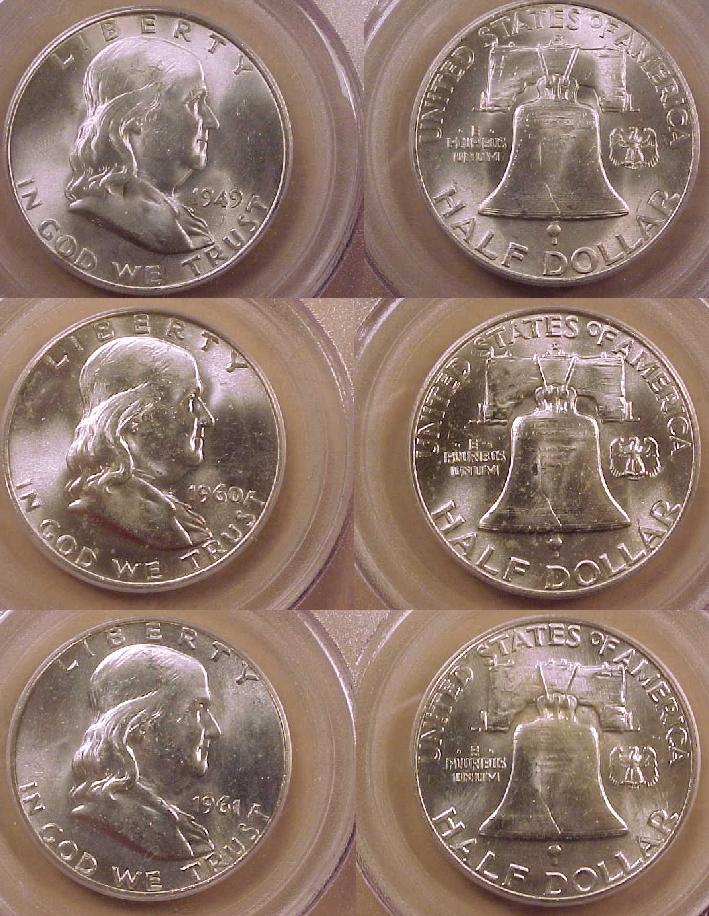
One final observation that
I will make is on the overall eye appeal of Franklins. Some people have a
general dislike for these coins, and as such will never even give old Ben a
second thought. For those of us who appreciate these coins, we know that overall
eye appeal can be very important. In this series, more than any other I think,
you can have great looking coins in MS63 or 64 because of luster and toning
combined, or you can have horrid looking coins in MS65 or 66 coins because
technically they meet the grade, but toning in particular is awful. To this I
say you have to pick out coins which are pleasing to you and which you feel
proud to display in your collections. Whether you love white coins, or coins
with great toning, the most important thing is that you like the coins you have.
Hopefully you will find this diatribe helpful. I’ve been holding off on
posting on this subject because it is a long and convoluted discussion, but for
those of you who enjoy the series, I feel it’s important to know what to look
for in great Franklins. I hope some of you will chime in and give your opinions
on this subject. Until then – Enjoy collecting Frankies!
2004 AETHELRED.NET. All rights reserved.
BACK TO HOME PAGE






